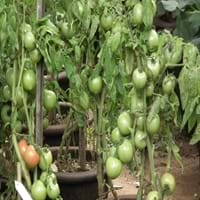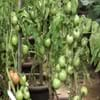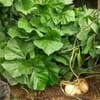Life Span
Annual and Perennial
Biennial and Perennial
Origin
Mexico, Central America, South America
Europe, Western Asia
Types
Plum Tomato, Serbian Tomato, Stupice Tomato
Not Available
Habitat
Cultivated Beds
waste ground, wastelands
USDA Hardiness Zone
11-15
4-9
Sunset Zone
A1, A2, A3, H1, H2, 1a, 1b, 2a, 2b, 3a, 3b, 4, 5, 6, 7, 8, 9, 10, 11, 12, 13, 14, 15, 16, 17, 18, 19, 20, 21, 22, 23, 24
A1, A2, A3, H1, H2, 1a, 1b, 2a, 2b, 3a, 3b, 4, 5, 6, 7, 8, 9, 10, 11, 12, 13, 14, 15, 16, 17, 18, 19, 20, 21, 22, 23, 24
Habit
Vining/Climbing
Rosette/Stemless
Flower Color
Yellow
Yellow
Flower Color Modifier
Bicolor
Bicolor
Fruit Color
Red, Rose, Coral
Brown, Black
Leaf Color in Spring
Green, Dark Green
Green
Leaf Color in Summer
Green, Dark Green
Green
Leaf Color in Fall
Green, Dark Green
Green
Leaf Color in Winter
Green, Dark Green
Not Available
Leaf Shape
Bell Shaped
Pinnate
Plant Season
Spring, Summer, Fall
Summer
Sunlight
Full Sun
Full Sun
Type of Soil
Loam, Sand
Loam
The pH of Soil
Neutral
Neutral
Soil Drainage
Well drained
Well drained
Bloom Time
Indeterminate
Summer
Tolerances
Drought
Drought
Where to Plant?
Container, Ground, Pot
Ground, Pot
How to Plant?
Seedlings, Transplanting
Seedlings
Plant Maintenance
Medium
Medium
Watering Requirements
Average Water Needs
Average Water Needs, Do Not over Water, Keep the ground moist but not water-logged
In Summer
Lots of watering
Lots of watering
In Spring
Moderate
Moderate
In Winter
Average Water
Average Water
Soil Type
Loam, Sand
Loam
Soil Drainage Capacity
Well drained
Well drained
Sun Exposure
Full Sun
Full Sun
Pruning
Cut or pinch the stems, Pinch Tips, Prune for shortening long shoots, Remove damaged leaves, Remove dead branches, Remove dead leaves, Remove short twigs, Remove tight V-branching crotches
Remove damaged leaves, Remove dead branches, Remove dead leaves
Fertilizers
Apply 5-10-5 amounts
All-Purpose Liquid Fertilizer
Pests and Diseases
Red blotch
Aphids, Armyworm, Cutworms, Downy mildew, Pitch canker, Red blotch
Plant Tolerance
Drought
Drought
Flower Petal Number
Single
Not Available
Fragrant Bark/Stem
Yes
Yes
Foliage Texture
Medium
Fine
Foliage Sheen
Matte
Matte
Attracts
Butterflies
Butterflies
Allergy
Abdominal pain, Dermatitis, Oral Allergy, Rhinitis, Urticaria
Stomach burn
Aesthetic Uses
Not Used For Aesthetic Purpose
Not Used For Aesthetic Purpose
Beauty Benefits
Good for skin
Blood purifying, Good for skin
Environmental Uses
Air purification, Food for animals, Food for birds, Food for insects
Air purification
Medicinal Uses
Antirheumatic, Cardiac, Homeopathy, Odontalgic
Aphrodisiac
Part of Plant Used
Fruits, Seeds
Root
Other Uses
Cosmetics, For making oil, Repellent, Used as an insecticide
Food for animals, Used as a nutritious food item
Used As Indoor Plant
Yes
Yes
Used As Outdoor Plant
Yes
Yes
Garden Design
Container, Edible, Herb, Vegetable, Vine
Edible, Herb, Vegetable
Botanical Name
LYCOPERSICON esculentum 'Soldacki'
PASTINACA sativa
Common Name
Tomato
Parsnip
In Hindi
बीफस्टीक टमाटर
पौधा
चुकंदर
In German
Beefsteaktomate
Pflanze
Pastinake
In French
tomate beefsteak
Plante
Panais
In Spanish
Bistec de tomate
Planta
Chirivía
In Greek
μπριζόλα Ντομάτα
Φυτό
Είδος δαυκίου
In Portuguese
tomate Redondo Vermelho
Plantar
cherivia
In Polish
befsztyk pomidorowy
Roślina
Pasternak
In Latin
Nullam beefsteak
planta
parsnip
Phylum
Magnoliophyta
Magnoliophyta
Class
Magnoliopsida
Magnoliopsida
Family
Solanaceae
Apiaceae
Clade
Angiosperms, Asterids, Eudicots
Angiosperms, Asterids, Eudicots
Tribe
Not Available
Not Available
Subfamily
Not Available
Not Available
Number of Species
Not Available
Properties of Beefsteak Tomato and Parsnip
Wondering what are the properties of Beefsteak Tomato and Parsnip? We provide you with everything About Beefsteak Tomato and Parsnip. Beefsteak Tomato doesn't have thorns and Parsnip doesn't have thorns. Also Beefsteak Tomato does not have fragrant flowers. Beefsteak Tomato has allergic reactions like Abdominal pain, Dermatitis, Oral Allergy, Rhinitis and Urticaria and Parsnip has allergic reactions like Abdominal pain, Dermatitis, Oral Allergy, Rhinitis and Urticaria. Compare all the properties and characteristics of these two plants. Find out which of these plant can be used as indoor plant. If you are interested to decorate your house and garden, find out aesthetic uses, compare them and select the plant which will beautify your surrounding. Along with beautification, try comparing medicinal and edible uses of Beefsteak Tomato and Parsnip and you can choose the plant having best and most benefits.
Season and Care of Beefsteak Tomato and Parsnip
Season and care of Beefsteak Tomato and Parsnip is important to know. While considering everything about Beefsteak Tomato and Parsnip Care, growing season is an essential factor. Beefsteak Tomato season is Spring, Summer and Fall and Parsnip season is Spring, Summer and Fall. The type of soil for Beefsteak Tomato is Loam, Sand and for Parsnip is Loam while the PH of soil for Beefsteak Tomato is Neutral and for Parsnip is Neutral.
Beefsteak Tomato and Parsnip Physical Information
Beefsteak Tomato and Parsnip physical information is very important for comparison. Beefsteak Tomato height is 182.88 cm and width 60.00 cm whereas Parsnip height is 15.20 cm and width 7.60 cm. The color specification of Beefsteak Tomato and Parsnip are as follows:
Beefsteak Tomato flower color: Yellow
Beefsteak Tomato leaf color: Green and Dark Green
Parsnip flower color: Yellow
- Parsnip leaf color: Green
Care of Beefsteak Tomato and Parsnip
Care of Beefsteak Tomato and Parsnip include pruning, fertilizers, watering etc. Beefsteak Tomato pruning is done Cut or pinch the stems, Pinch Tips, Prune for shortening long shoots, Remove damaged leaves, Remove dead branches, Remove dead leaves, Remove short twigs and Remove tight V-branching crotches and Parsnip pruning is done Remove damaged leaves, Remove dead branches and Remove dead leaves. In summer Beefsteak Tomato needs Lots of watering and in winter, it needs Average Water. Whereas, in summer Parsnip needs Lots of watering and in winter, it needs Average Water.





